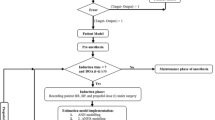Abstract
In this study, a fuzzy logic-based anesthetic depth decision support system (ADDSS) was realized for anesthetic depth control to help anesthetists in surgeries. Depth of anesthesia for a patient can change according to anesthetic agent and characteristic properties of a patient such as age, weight, etc. During the surgery, depth of anesthesia of a patient is determined by the experience of anesthetist controlling of systolic arterial pressure (SAP) and heart pulse rate (HPR) parameters. Anesthetists could have tired and lost attention by inhaling of anesthetic gas leaks in long lasted operations. For that reason, improper anesthetic depth could be applied to the patients. So anesthesia could not be safety and comfortable. To remove this unwanted situation, an ADDSS was proposed for anesthetists. By the help of this system, precise anesthetic depth could have provided. Thus, the anesthetist will spend less time to provide anesthetic and the patient will have a safer and less expensive operation. This study was performed under sevoflurane anesthetic.








Similar content being viewed by others
References
Marshall, B. E., and Lockenfger, D. E., General anaesthetics, Goodman and Gilman’s, the pharmocological basis of therapeutics. 8th Edition. Oxford: Permagon Press, 1990, pp. 285–311.
Snow J. C., Anestezi El Kitabı: Izmir Guven Kitapevi, Izmir, 1986.
Saraoglu, H. M., and Sanlı, S., Fuzzy logic based anesthetic depth control, 2003 ICIS International Conference on signal processing (ICSP 2003), September 24–26. Çanakkale, Turkey, 2003.
Mahfouf, M., Asbury, A. J., and Likens, D. A., Unconstrained and constrained generalized predictive control of depth of anesthesia during surgery. Control. Eng. Pract. 11:1501–1515, 2003.
Becker, K., Thull, B., Kasmacher-Leidinger, H., Stemmer, J., Rau, G., Kalf, G., and Zimmermann, H., Design and validation of an intelligent patient monitoring and alarm system based on fuzzy logic process model. Artif. Intell. Med. 11:33–53, 1997.
Vefghi, L., and Linkens, D. A., Internal representation in neural networks used for classification of patient anesthetic states and dosage. Comput. Methods Programs Biomed. 59, 1999 pp. 75–89.
Pis P., and Mesiar,R., Fuzzy model of inexact reasoning in medicine. Comput. Methods Programs Biomed. 30:1–8, 1989.
Greenhow, S. G., Linkens, D. A., and Asbury, A., Pilot study of an expert system adviser for controlling general anesthesia. Br. J. Anaesth. 71:359–365, 1993.
Zbinden, A. M., Feigenwinter, P., and Hutmacher, M., Fresh gas utilization of eight circle system. Br. J. Anaesth. 67:492–499, 1991.
Bengstone, J. P., Sonader, H., and Stenquvist, O., Comparison of cost of different anesthetic techniques. Acta Anaesthesiol. Scand. 32:33–35, 1998.
Linkens, D. A. Adaptive and intelligent control in anaesthesia. IEEE Control Syst. Mag. 12(6):6–11, 1992.
Vickers, M. D., Schniede, H., and Wood-Smith, F. G., Drugs in anaesthetic practice. 6th Edition. London: Butterworths, 1984.
Merer, R., Nieuwland J., Zbinden, A. M., and Hacisalihzade, S. S., Fuzzy logic control of blood pressure during anesthesia. IEEE Control Syst. Mag. 12(9):12–17, 1992.
Zadeh, L. A., Fuzzy sets. Inf. Control. 8:38–53, 1967.
Temurtas, F., Fast detection of the hazardous organic gases in the ambient air using adaptive neuro-fuzzy inference systems. Int. J. Environ. Pollut. 28(3/4), 2006.
Yea, B., Osaki, T., Sugahara, K., and Konishi, R., Improvement of concentration estimation algorithm for inflammable gases utilizing fuzzy rule based neural networks. Sens. Actuators B Chem. 56:181–188, 1999.
Mamdani, E. H., and Assilian, S., An experiment in linguistic synthesis with a fuzzy logic controller. Int. J. Man-Mach. Stud. 7(1):1–13, 1975.
MATLAB® Documentation (2002) Neural Network Toolbox Help, Version 6.5, Release 13, MathWorks, 3 Apple Hill Drive Natick, MA.
Acknowledgements
We would like to thank the Kütahya State Hospital officials for providing the medical data for the present study.
Author information
Authors and Affiliations
Corresponding author
Rights and permissions
About this article
Cite this article
Saraoğlu, H.M., Şanlı, S. A Fuzzy Logic-Based Decision Support System on Anesthetic Depth Control for Helping Anesthetists in Surgeries. J Med Syst 31, 511–519 (2007). https://doi.org/10.1007/s10916-007-9092-x
Received:
Accepted:
Published:
Issue Date:
DOI: https://doi.org/10.1007/s10916-007-9092-x




